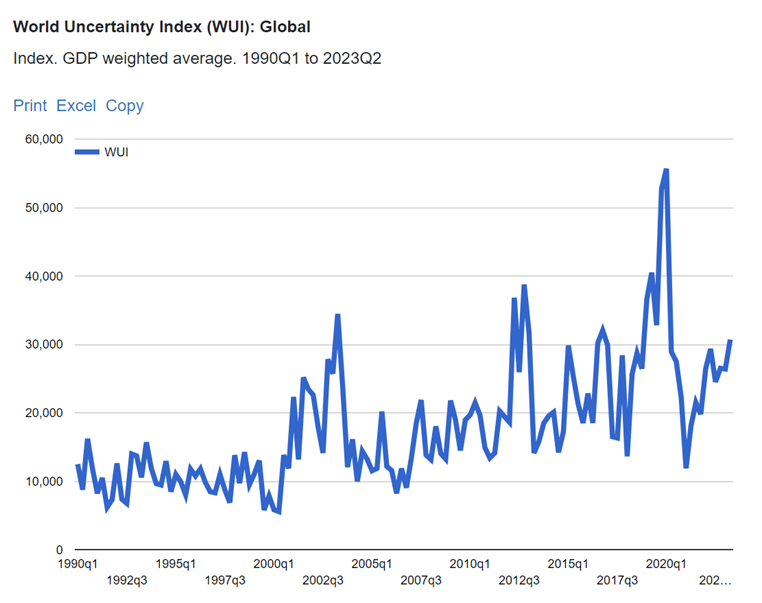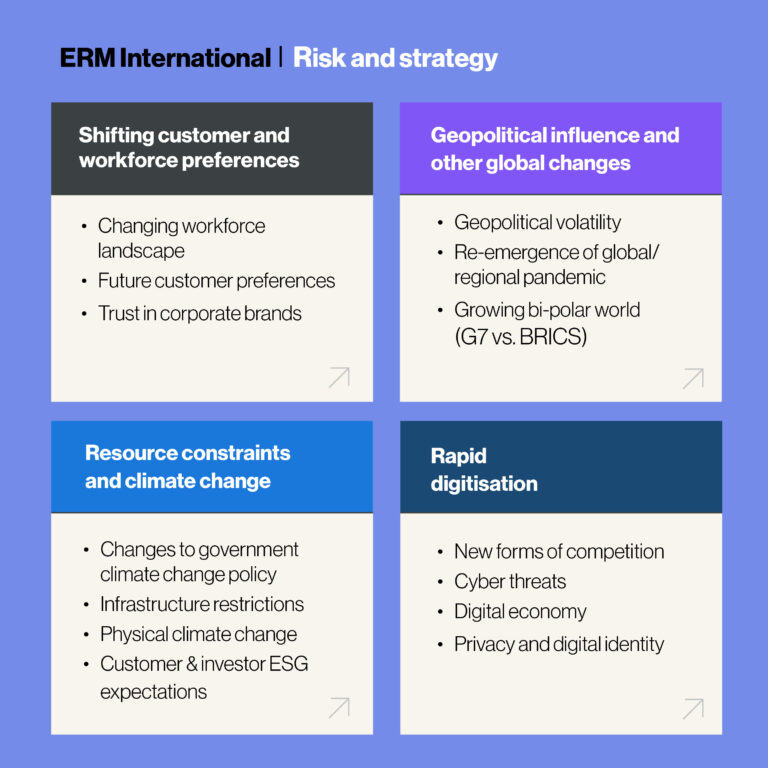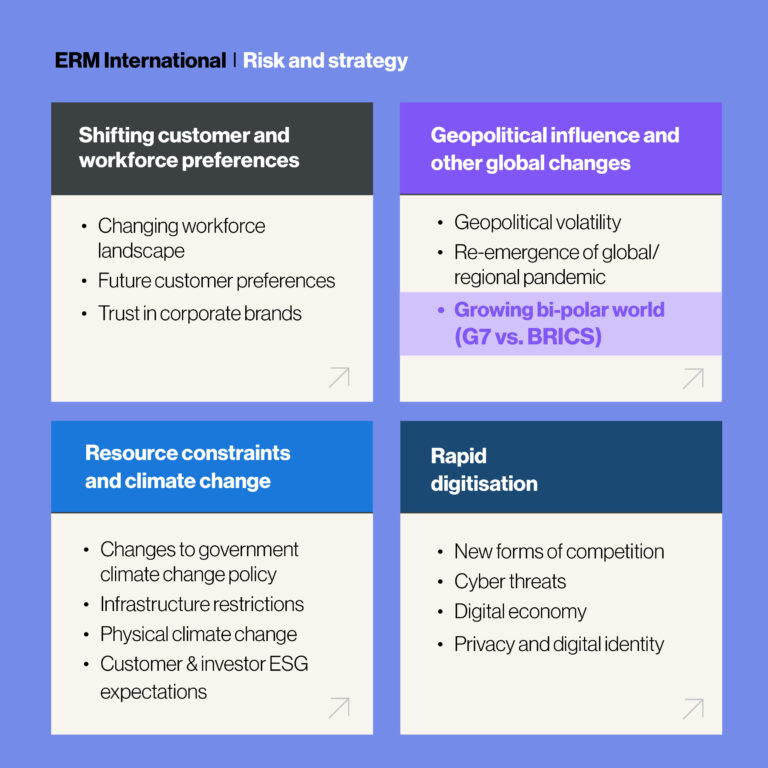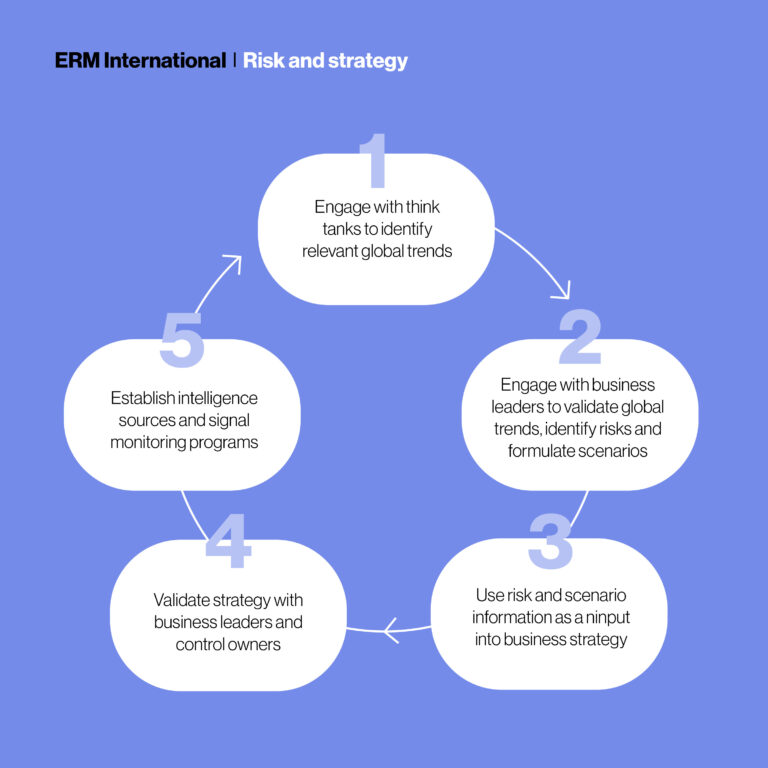Strategic risk management and business strategy
Global uncertainty requires improved precision in strategic choices. Strategic risk management can help. Jereme Evans, General Manager at ERM International Middle East, shares how he is guiding companies around the world to take a proactive approach.

Global uncertainty requires proactive approach
Global uncertainty is on the rise. While not at ‘early pandemic levels’, the World Uncertainty Index currently reflects elevated uncertainty in the general economic and industry outlook.
Source: World Uncertainty Index, a measure of the volume of the word ‘uncertain’ (or its variations) in the Economist Intelligence Unit country reports.
When developing an organisational strategic plan, leaders must form a clear and multi-faceted understanding of their current (and potential future) operating environment. This becomes more difficult when there are a growing number of market forming or shifting events.
Strategic risk management can help businesses to examine global trends and assess diverse scenarios.
At ERM International, we analyse each strategic risk category to gain a more holistic understanding of the global and local landscape in which your organisation is operating. Applying this structured approach can help you to challenge existing assumptions and improve precision in your strategic decision making.
Our process also helps leaders to understand their organisation’s preparedness to respond to a range of strategic risks.
In the chart below, you see an example of some of the common contemporary strategic risk categories we help our customers to explore in a customised way for their business.
Macro risk management: identifying global trends
How do you assess which global trends will and won’t influence your industry and organisation?
At ERM International, we use our unique horizon scanning methodology to look at external conditions that influence numerous economies and drill down into more specific scenarios that are relevant to you.
NGO and industry group risk information is a strong starting point, but what do you do with this information? Input from enterprise leaders and internal context is also required.
Developing a deep knowledge of global trends, their direction and their velocity – alongside a detailed understanding of your business – is what helps us anticipate the magnitude of change and the timing for when you may need to introduce controls.
This can also help organisations to identify which competitive advantages can be adopted or which strategies may improve resilience to a negative macro event.
For example, below we show the strategic risk categories chart from our previous #strategicrisk post, but this time with one of the geopolitical scenarios highlighted. In this scenario, we examine the possibility that geopolitical volatility results in a growing global split between G7 and BRICS economies.
Depending on your business locations, this situation might encourage a shift towards regional activities (vs global trade) or a decision to enter or exit certain markets.
Making these links between the global trends and the business impacts is a crucial role of strategic risk management. It’s also important to ensure the process is approached methodically so as to ensure internal biases or preferences don’t steer the conversation to a misleading confusion.
We have the expertise to help you step through the risks involved across multiple scenarios.
Using risk management in business strategy
How is your strategic risk management profile used when developing your organisation’s strategic plan?
Does it define when both the controls need to be implemented and when the risk will start to materialise?
Incorporating known strategic risks into your strategic plan can markedly improve your organisational resilience from global/regional changes.
Bringing in risk at this early planning stage means you are also more likely to incorporate initiatives that act as key controls for managing risks from day one.
Although the theory of using strategic risk management to form and deliver an organisation’s business strategy is not controversial, we don’t often see it applied in practice. Yet there are significant potential benefits.
Implementing such initiatives requires a coordinated approach with stakeholders, where portions of work are typically incorporated into business unit specific plans.
ERM International has worked with numerous multinational organisations to achieve this result. We can guide your organisation through the five fundamental steps below to incorporate strategic risk management into your business strategy.
Anticipating changes and implementing controls
How do organisations prioritise and execute different initiatives for managing strategic risks?
And how do you then assess the effectiveness of those controls or initiatives?
When assessing global trends and identifying strategic risks, it is vital to use reliable and reputable intelligence sources. These will have a direct influence on not only how the risk is defined but how you establish controls.
If you have identified relevant signposts and clear trigger points for when a risk is moving towards a pessimistic – or an optimistic – scenario, you will be in a much stronger position to make the best strategic decisions for your business.
If your signposts indicate that a risk is evolving, you need to be able to amend your controls accordingly.
Organisations must to ask themselves: ‘what are our contingency plans if things move unfavourably against our strategy (i.e. toward the pessimistic scenario)’? Or: ‘how can we accelerate plans if things move favourably (i.e. toward the optimistic scenario)’?
Managing strategic risks is not about beating the external movement itself. Most times this is beyond control of the organisation. It is about being able to respond faster and better than your competitor.
This is how you get a competitive advantage. This is how you WIN!
Where to next?
Jereme Evans is General Manager of our ERM International Middle East business. Keen to chat? Get in touch to organise a time.
Leave a comment
Recent posts
A sporting chance – using risk to get ahead of the…
Seeing blind spots, being prepared and taking risk strategically are all key to ensuring an organization can kick goals.
How to see what you don’t see – a practical approach
COVID-19 prompted organisations around the world to ask: what else are we blind to? We run through our risk radar approach.






